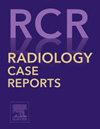Wandering spleen with torsion in pelvic: A case report and literature review
Q4 Medicine
引用次数: 0
Abstract
Wandering spleen, caused by elongation or maldevelopment of the splenic ligaments, is a rare developmental disorder with a prevalence of 0.2 %. It occurs primarily in children under one year or adult women of reproductive age. Clinical manifestations are highly variable, ranging from asymptomatic cases to acute abdominal symptoms such as persistent abdominal pain and vomiting, often due to splenic torsion. Because clinical symptoms are nonspecific, diagnostic imaging is crucial, with computed tomography key to confirming the diagnosis. Conventional treatment involves spleen fixation unless there is splenic infarction, in which case splenectomy should be considered.
We report the case of a 13-year-old female patient who was admitted to the hospital with acute abdominal pain, accompanied by vomiting and fever, without signs of shock. Ultrasound and computed tomography revealed splenic torsion, which was confirmed during laparoscopic surgery, and the patient subsequently underwent splenectomy. One week after surgery, the patient was discharged from the hospital in stable condition.
求助全文
约1分钟内获得全文
求助全文
来源期刊

Radiology Case Reports
Medicine-Radiology, Nuclear Medicine and Imaging
CiteScore
1.10
自引率
0.00%
发文量
1074
审稿时长
30 days
期刊介绍:
The content of this journal is exclusively case reports that feature diagnostic imaging. Categories in which case reports can be placed include the musculoskeletal system, spine, central nervous system, head and neck, cardiovascular, chest, gastrointestinal, genitourinary, multisystem, pediatric, emergency, women''s imaging, oncologic, normal variants, medical devices, foreign bodies, interventional radiology, nuclear medicine, molecular imaging, ultrasonography, imaging artifacts, forensic, anthropological, and medical-legal. Articles must be well-documented and include a review of the appropriate literature.
 求助内容:
求助内容: 应助结果提醒方式:
应助结果提醒方式:


